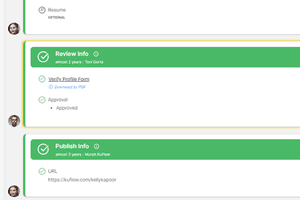Unlocking Customer Service Excellence with KuFlow
Published 18-04-2024 by KuFlow Team

Credits: Pexels
Introducing the Power of Process Automation in Customer Service and Support
In today's rapidly evolving business landscape, the customer experience stands as the cornerstone of success. As businesses strive to meet the ever-growing demands and expectations of their clientele, the role of customer service and support has become increasingly pivotal. Yet, with this heightened significance comes the challenge of managing an influx of inquiries, issues, and requests while maintaining efficiency and quality. This is where the transformative power of process automation emerges as a beacon of innovation and opportunity.
But what does this truly entail?
Imagine a scenario where routine inquiries are swiftly addressed through intelligent software workers, capable of providing immediate resolutions or seamlessly routing complex cases to human agents. Picture a system where tickets are automatically categorized, prioritized, and assigned to the most suitable representatives, ensuring rapid response times and efficient resolution cycles. Envision a reality where personalized recommendations and proactive outreach initiatives are orchestrated seamlessly, fostering deeper engagement and loyalty among customers.
In essence, process automation is not only about mere efficiency; it embodies a paradigm shift towards proactive, predictive, and personalized customer engagement.
In this article, we delve into the intricacies of process automation within the domain of customer service and support, exploring its transformative potential, tangible benefits, and real-world applications.
Unlocking the Benefits of Process Automation
As organizations navigate the complexities of modern customer service and support, the adoption of process automation emerges as a strategic imperative with interesting transformative benefits:
- More availability of customer support services. By leveraging automated solutions such as chatbots and self-service portals, businesses can ensure round-the-clock accessibility, empowering customers to seek assistance at their convenience without being bound by business hours or geographical boundaries.
- Cut down on operational costs substantially. By automating routine tasks and workflows, organizations can achieve greater efficiency and resource optimization, mitigating the need for extensive human intervention and minimizing overhead expenses associated with manual processes.
- Elimination of manual tasks that are prone to errors and inefficiencies. Through the automation of repetitive and labor-intensive activities, such as data entry, ticket routing, and documentation, businesses can streamline operations, reduce error rates, and enhance overall process accuracy and reliability.
- Support for human agents, augmenting their capabilities and enabling them to focus on high-value tasks that require human expertise and empathy. By automating routine inquiries and administrative tasks, support agents can devote more time and attention to complex problem-solving, relationship-building, and personalized customer interactions, thereby enhancing the quality and efficacy of customer service delivery.
- Improving customer service metrics across the board. By optimizing response times, reducing resolution times, and enhancing the overall customer experience, businesses can achieve higher levels of customer satisfaction, retention, and loyalty, ultimately driving long-term growth and profitability.
10 Concrete Examples of Customer Service Automation
1. Customer Information Pre-Handling and Retrieval
Automating the collection and retrieval of customer information from various systems at the outset of customer interactions. This ensures that agents have access to relevant data upfront, streamlining the resolution process and enhancing personalized service delivery.
2. Automatic Ticket Classification
Implementing automatic ticket classification systems to channelize or categorize responses. This ensures that incoming tickets are efficiently routed to the appropriate teams or agents, speeding up resolution times and improving overall customer satisfaction.
3. Ticket Automation
Automating ticket management processes, including the automation of communications such as email or direct messages on social media platforms, utilizing predefined responses (canned responses). This ensures timely responses and consistency in communication while freeing up agents to focus on more complex tasks
4. Utilizing KuFlow as a Case Manager
Deploying KuFlow as a case management solution that sits atop existing customer service tools. This enables the creation of integrated workflows, seamlessly integrating applications without disrupting the existing contact center ecosystem.
5. Integration with various company tools
Integrating KuFlow with different company tools via APIs or Robotic Process Automation (RPA) facilitates the updating of basic customer data or the addition of new data, as well as recording customer feedback obtained from separate systems. This eliminates the need for agents to navigate between multiple programs to access and update data (e.g., contact history, lead scoring, order history) from information gathered from emails, texts, surveys, etc.
6. Customer Account Verification
KuFlow can handle preliminary customer data checks at the onset of a ticket, relieving human agents of manual work. By automating account verification processes, the KuFlow worker can ensure that customer information is accurate and up-to-date, expediting the resolution process and enhancing overall efficiency.
7. Automatic Responses to common queries
Implementing a system of automatic responses for frequently asked questions promotes user self-service and frees up human resources for more complex tasks. By accessing the ticket database, KuFlow can automatically address common customer inquiries such as password resets, order modifications, and shipping inquiries. This not only reduces response times but also enhances the customer experience by providing swift and accurate resolutions to routine issues.
8. Automatic message translation for multilingual support
Enabling automatic translation of messages to provide support in other languages. By integrating translation capabilities into the system, businesses can ensure seamless communication with customers regardless of language barriers, expanding their reach and enhancing inclusivity.
9. Integration with Artificial Intelligence Solutions
Integrating KuFlow with Artificial Intelligence solutions, such as chatbots and similar technologies, enhances the capabilities of customer service by providing automated assistance and responses, improving efficiency and scalability.
10. Automated status monitoring for preventive maintenance
This encompasses proactive monitoring of systems and statuses. By leveraging advanced analytics and machine learning algorithms, KuFlow can predict customer behaviors and preemptively address potential issues before they escalate. This proactive approach not only improves operational efficiency but also fosters customer satisfaction and loyalty by anticipating and meeting their needs effectively.
Conclusions: Transforming Customer Service with KuFlow
In the dynamic landscape of modern customer service, the adoption of automation technologies has emerged as a pivotal strategy for businesses seeking to enhance efficiency, improve customer experiences, and drive growth.
From the seamless integration with existing tools to the automation of ticket management processes, KuFlow offers a flexible backoffice solution designed to meet the evolving needs of today's customer-centric organizations. In essence, KuFlow represents not just a tool, but a transformative platform driving innovation and differentiation in the competitive landscape of customer service. As businesses continue to adapt and evolve in response to changing customer expectations, KuFlow stands as a trusted ally, enabling organizations to deliver seamless, efficient, and memorable experiences that drive long-term loyalty and success.
By harnessing the power of automation, businesses can achieve unprecedented levels of operational efficiency, ensuring timely responses, personalized interactions, and consistent service delivery.
In conclusion, with KuFlow as an asset for their customer service strategy, businesses can embark on a journey of digital transformation, reimagining the possibilities and redefining the standards of service excellence in the digital age.
Visit us at KuFlow to start your automation journey.





